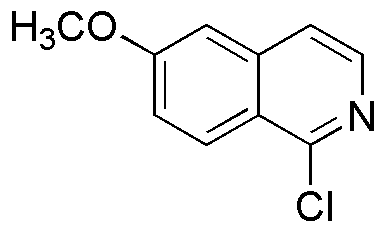1-Chloro-6-methoxy-isoquinoline is widely utilized in research focused on:
- Pharmaceutical Development: This compound serves as a crucial intermediate in the synthesis of various pharmaceuticals, particularly in developing drugs targeting neurological disorders.
- Organic Synthesis: It is employed in organic chemistry for creating complex molecular structures, making it valuable for researchers in academia and industry looking to innovate new compounds.
- Biological Research: The compound is used in studies investigating its biological activity, particularly its potential as an anti-cancer agent, providing insights into new treatment pathways.
- Material Science: It finds applications in developing advanced materials, such as organic light-emitting diodes (OLEDs), enhancing the performance and efficiency of electronic devices.
- Analytical Chemistry: This chemical is utilized in analytical methods to detect and quantify isoquinoline derivatives, aiding researchers in quality control and environmental monitoring.
General Information
Properties
Safety and Regulations
Applications
1-Chloro-6-methoxy-isoquinoline is widely utilized in research focused on:
- Pharmaceutical Development: This compound serves as a crucial intermediate in the synthesis of various pharmaceuticals, particularly in developing drugs targeting neurological disorders.
- Organic Synthesis: It is employed in organic chemistry for creating complex molecular structures, making it valuable for researchers in academia and industry looking to innovate new compounds.
- Biological Research: The compound is used in studies investigating its biological activity, particularly its potential as an anti-cancer agent, providing insights into new treatment pathways.
- Material Science: It finds applications in developing advanced materials, such as organic light-emitting diodes (OLEDs), enhancing the performance and efficiency of electronic devices.
- Analytical Chemistry: This chemical is utilized in analytical methods to detect and quantify isoquinoline derivatives, aiding researchers in quality control and environmental monitoring.
Documents
Safety Data Sheets (SDS)
The SDS provides comprehensive safety information on handling, storage, and disposal of the product.
Product Specification (PS)
The PS provides a comprehensive breakdown of the product’s properties, including chemical composition, physical state, purity, and storage requirements. It also details acceptable quality ranges and the product's intended applications.
Certificates of Analysis (COA)
Search for Certificates of Analysis (COA) by entering the products Lot Number. Lot and Batch Numbers can be found on a product’s label following the words ‘Lot’ or ‘Batch’.
*Catalog Number
*Lot Number
Certificates Of Origin (COO)
This COO confirms the country where the product was manufactured, and also details the materials and components used in it and whether it is derived from natural, synthetic, or other specific sources. This certificate may be required for customs, trade, and regulatory compliance.
*Catalog Number
*Lot Number
Safety Data Sheets (SDS)
The SDS provides comprehensive safety information on handling, storage, and disposal of the product.
DownloadProduct Specification (PS)
The PS provides a comprehensive breakdown of the product’s properties, including chemical composition, physical state, purity, and storage requirements. It also details acceptable quality ranges and the product's intended applications.
DownloadCertificates of Analysis (COA)
Search for Certificates of Analysis (COA) by entering the products Lot Number. Lot and Batch Numbers can be found on a product’s label following the words ‘Lot’ or ‘Batch’.
*Catalog Number
*Lot Number
Certificates Of Origin (COO)
This COO confirms the country where the product was manufactured, and also details the materials and components used in it and whether it is derived from natural, synthetic, or other specific sources. This certificate may be required for customs, trade, and regulatory compliance.


